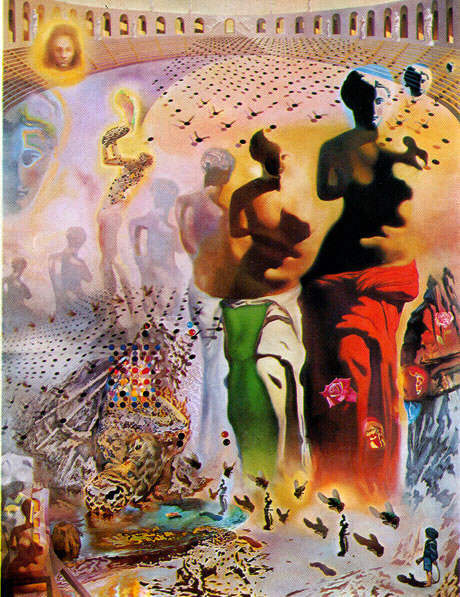-


 Salvador Dali
Salvador Dali
Spanish
Artist
Salvador Dali was born on the May 11, 1904 in the Spanish town of Figueres, Catalonia. His parents provided Dali and his sister with a comfortable upbringing. The young Salvador Dali drew from an early age and was encouraged by his sympathetic mother. She died of cancer when the artist was just 16 though, and his father remarried the sister of his mother. Salvador Dali is considered as the greatest artist of the surrealist art movement and one of the greatest Master of Art of the twentieth century. Dali's name is synonymous with the Surrealist art movement.
Salvador Dali was an eccentric Spanish painter that understood how the media worked and used it to its full potential. Dali was a prolific artist, creating more than 1500 paintings during his life time and many works in other mediums, including prints, drawings, sculpture, book illustration, and theater set designs. During his lifetime the public got a picture of a bizarre paranoid. His personality caused a lot of controversy. The most famous work of Salvador Dali is "The Persistence Of Memory"(shown here), which introduced the surrealistic image of the soft, melting pocket watch, The general interpretation of the work is that the soft watches debunk the assumption that time is rigid or deterministic, and this sense is supported by other images in the work, such as the wide expanding landscape and the ants and fly devouring the other watches.
A flamboyant painter and sometime writer, sculptor and experimental film-maker, Salvador Dali used bizarre dream imagery to create unforgettable and unmistakable landscapes of his inner world. Dali's talent as an artist showed at an early age and he received his first drawing lessons when he was ten years old. His art teachers were a then well known Spanish impressionist painter, Ramon Pichot and later an art professor at the Municipal Drawing School. In 1922 Salvador Dali moved to Madrid to study painting at the Academy of Arts. Here he began to develop a reputation as an eccentric, attracting attention with his manner of dress, hairstyles, and comments on art. In 1923 his father bought Salvador Dali his first printing press.
"The only difference between me and a madman is that I am not mad" - Salvador Dali
Artist Salvador Dali experimented with forms of Cubism and Dadaism during his studies. He was expelled twice and never took the final examinations. His opinion was that he was more qualified than those who should have examined him. Early recognition of Dali's talent came with his first one-man show, held in Barcelona in 1925. Salvador Dali received international fame when three of his paintings were shown in the third annual Carnegie International Exhibition in Pittsburgh in 1928. In a way, this was his prime 'starting block'.
Salvador Dali moved to Paris, France to pursue his career as an artist and to be amongst many of the most progressive artists of the time. It was here that Dali met Pablo Picasso for the first time, a fellow Spaniard whom he greatly admired. Salvador Dali also became involved with Andre Breton and the Surrealist art movement. Around this time Salvador Dali also created surreal works that would come to represent what Surrealism was to many people, with works like "The Great Masturbator" and the famous Dali melting clocks "The Persistence of Memory".
In 1933 Salvador Dali had his first one-man show in New York. One year later he visited the U.S. for the first time supported by a loan of $500 from Pablo Picasso. To evade World War II, Dali chose the U.S.A. as his permanent residence in 1940. Salvador Dali had a series of spectacular exhibitions, among others a great retrospective at the Museum of Modern Art in New York. Besides creating a number of great paintings, Dali caused the attention of the media by playing the role of a surrealist clown. Salvador Dali made a lot of money and was contemptuously nicknamed Avida Dollars (greedy for dollars) by Andre Breton. Dali became the darling of the American High Society. Celebrities like Jack Warner or Helena Rubinstein gave him commissions for portraits. Salvador Dali's art works became a popular trademark and besides painting he pursued other activities, including jewelry and clothing designs for Coco Chanel, and film making with Alfred Hitchcock.
Salvador Dali painted the "Hallucinogenic Toreador" in 1970, following the canons of his particular interpretation of surrealist thought. The entire scene is contained within a bullfighting ring, submerged under a barrage of red and yellow tones, alluring tentatively to the colors of the Spanish flag. In the upper left section, we observe a representational portrait of his wife, Gala, to whom he dedicated this piece. Her serious, rigid expression could be interpreted as a pictorial representation of her deep-seated dislike for Bullfighting. In the bottom left section, a pattern of multicolored circles is made evident. This rectangular-shaped burst of colors immediately grasps the viewer’s attention and steers it down towards the visibly emerging shape of a dying bull’s head, dripping blood and saliva from its mouth.
In 1958 surrealist artist Salvador Dali began his series of large sized history paintings. He painted one monumental painting every year during the summer months in Lligat. The most famous one, "The Discovery of America by Christopher Columbus" can be seen at the Dali Museum in St. Petersburg Florida.